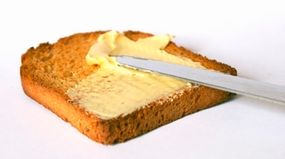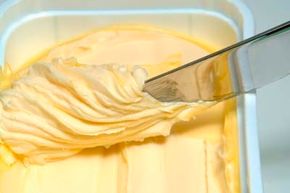Advertisement
Q. Why cream butter before mixing?
A. Creaming butter creates a specific effect in many baking recipes, so it shouldn't be eliminated for the sake of time. Creaming incorporates air into a batter or mixture so that the recipe will be light in texture and rise when baked.
Generally, room temperature butter is creamed first, followed by the addition of sugar until the mixture is smooth. The sugar crystals cut into the fat, creating air bubbles. Next, eggs are beaten in to help with the emulsion, and the rest of the wet ingredients are added. Finally, the dry ingredients are mixed in.
Advertisement
If you over-cream butter or use butter that is too warm or melted, the milk solids may separate from the fat. That will prevent air bubbles from forming when the sugar is added. If the butter is too cold, the sugar crystals may not be able to cut into it as effectively. Fewer air bubbles will be formed, resulting in a dense, flat product with an unappealing taste.
Q. What is the difference between salted and unsalted butter?
A. The USDA allows dairy processors to vary the amount of salt they add when they make butter. Butter's salt content is usually 1.5 percent to 2 percent, but can be as much as 3 percent. So, you can't really be sure how much salt the butter you're using will add to the recipe, and how salty your dish will be.
Using unsalted butter allows you to control the amount of salt that goes into your dish. You can always add more salt or leave some out.
Advertisement
Q. What's the difference between butter and margarine?
Butter is made from an animal fat and contains saturated fats, which are the type of fat that raises blood cholesterol levels. Margarines are made from vegetable oils, but trans-fatty acids are created during processing when vegetable oils are hydrogenated or hardened into a solid form. Manufactured trans fats, such as naturally occurring saturated fats, raise cholesterol.
However, soft or liquid margarines are lower in trans and saturated fats than solid margarines and butter.Fats that are better for you include vegetable oils such as olive, canola, soybean, and corn. These do not contain saturated or trans fats and tend to lower cholesterol levels.
Advertisement

Think for a moment of a "yardstick" of fats: You have the "good" oils on one end and butter on the other end. In between are margarines, with the softer margarines without trans fats being better than the solid or stick margarines.
If you choose butter, oil, or margarine, be careful of the amounts you eat. All three are calorie-dense foods, and the calories add up fast. Whenever possible in baking, cooking, or as spread, use a liquid oil. If you use margarine, choose one with a liquid oil as the first ingredient -- and the softer the better.
The differences produced in a recipe by substituting one type of fat for another can be quite profound. These differences can be even more pronounced depending on the type of margarine you used.
According to the National Association of Margarine Manufacturers, margarines with at least a 60 percent oil content are the most suitable for use as a substitute for butter in baking. However, even these spreads cannot replace butter in some recipes (such as puff pastry, pie crusts, and spritz cookies) that require specific ratios of fat and moisture in order to succeed.
In addition, if the margarine was fairly warm or if it got too warm while you were creaming it with the sugar, your baked good will go flat. If you can slice off a pat of the margarine without feeling any resistance, it is probably too warm to use.
Advertisement
Buttered up for more? Check out these recipes:
- Tasty Butters
- Strawberry Butter
- Chili Butter
- Apricot Butter
- See all Food & Recipes articles
Advertisement












